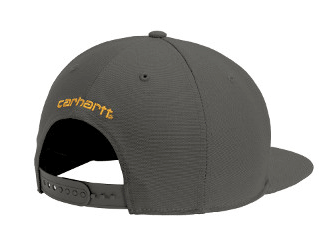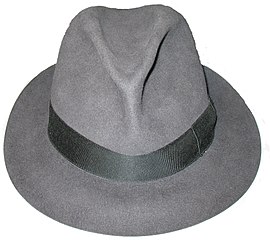A Guide to Hats, Caps and Headwear
Nov 1st 2022
A guide to hats, caps and headwear. In this entry we first explore the origin and uses of hats. In the second section we unlock the mystery between the various types of baseball caps. Ever wonder why the world needs so many different types of caps? Just what is the difference between low profile and high profile, what is a structured cap and so on? This is your guide to hats, caps and headwear.
Hats have been around for hundreds of years and their uses and styles are as varied as the options at your local buffet. There are hundreds of different styles of hats but the most popular hat these days is the baseball hat. Hats can be made of cotton, polyester, straw, felt and many more materials.
Brief History
The first known evidence of hats< appears in drawings from Ancient Greece. Most of the early hats were worn by the higher society individuals or the wealthy. These people would have their very own hat makers known as a “milliner” - named after Milan Italy - where the best hats were made in the 18th century. Most milliners from that era were women. Early hats were an indicator of Military rank or occupation as can still be seen all over the world today. Among the most famous hat makers in the United States is John B. Stetson of the Stetson hat company. They are responsible for creating what most of us recognize as the Cowboy hat. In some cases hats are required attire at many horse races and formal events. These are among the last places where you will find very high end and extravagant hats. Hats have a deep history and have changed a lot over the generations. It used to be in the 30's, 40's and 50's people would never leave the house without a hat. The men would don a dress hat similar to a fedora or a Cabbie Hat and the women would wear something more extravagant that was often decorated with lace or flowers or combinations of similar accessories. As we entered into the 1960's the custom of wearing hats every time you left the house faded. Now a days you will most commonly grab a baseball cap if you are leaving the house with a hat.
Have a look at a Stetson hat being made:
Uses
Hats have a great variety of uses. We have already discussed the hats that identify members of the military. There are also hats for occupations such as a baker's hat, also known as a Toque. Then there are hard hats made of hard plastic to protect construction workers from falling debris. The bishops and Pope of the Roman Catholic Church wear a Mitre, while we may wear a knit beanie in the winter to protect against the cold or a sun hat in the summer to product us from the sun. A baseball player would wear a baseball cap as part of his uniform and to identify his team while I, as a fan, would wear the same hat to show my support. These are just a small sampling of all the uses for hats.
Baseball cap
The Baseball cap is so popular across the world that it deserves special attention. A baseball cap is a soft, rounded-top hat with a stiff bill coming off the front. Almost all baseball caps are made of cotton, brushed-cotton to be exact. This is something most people don’t know. The brushed-cotton looks like canvas and has similar properties to it but it is really just the process of making the hat hold up a little better. True baseball caps have the team logo on the front of them and are part of the official uniform but in this instance they do not need to have a logo as we are referring to the Baseball cap as a style of hat and not specifically for the sport. Most Baseball caps these days are worn causally as opposed to being for the game. Baseball hats can be fitted, which is solid all the way around with some flex in them or can be adjustable. In 1860 the Baseball team Brooklyn Excelsior wore the first of what resembled today’s modern Baseball hat. In 1940 rubber latex was added to the inside of the hat to give it more structure than the previously unstructured Baseball caps. This gave rise to what we now know as the modern Baseball cap.
Features of the hat:
Hats have many features that are for both style and function. These can be important to know in choosing the right hat for your project. There are a few basic features found in any hat. They are Crown, Peak, Brim and hatband. The crown of the hat is the rounded main section of the hat that covers the head. We also refer to this as the bell. The peak or bill is the stiff portion of the hat coming off the front to shade the eyes. A brim is also a projection but it covers the circumference of the hat. You will find a brim in a fishing or sun hat. The sweatband is a band that runs around the circumference of the inside of the hat for comfort and protection against sweating.
What are the differences in Baseball Caps?
- Structured vs. unstructured: The shape and structure are possibly the most important. In a baseball style hat you have the options of a structured or unstructured. The best way to think of this is a structured hat will keep its shape when taken off and set on a table. An unstructured hat will not keep its shape and will more or less flop when placed on a table; the crown has a “stiffer feel.”
- Profile – low to high: Another important feature of these hats is the profile. The easiest way to think of profile is how far off your forehead the hat comes. A low profile hat will hug your forehead on up to the top of the hat. A mid profile hat will come off your forehead just a bit and a high profile hat will stick up quite a bit off the top of your head. Professional style baseball hats are high profile and structured.
- Type of Closure: The next part of the cap is the closure – this is found on the back of the hat and is also known as an opening. There are two basic types of caps in this regard, fitted and adjustable. A fitted cap does not have an adjustment but comes in 2 or 3 sizes, using a form of elastic insert to allow the sweatband to expand or contract to fit different sized heads. Adjustable closures apply to hats that you can adjust. The most common closure is Hook and Loop. Hook and loop is just like Velcro but many manufacturers are not using the trademarked Velcro so they have to use the words hook and loop to describe it. The next closure is the slide buckle closure. This involves a few pieces of fabric and a brass slide buckle that can be used to tighten or loosen the back of the hat. This is just like a belt you would wear to hold up your pants. The final of the common closures is the snap back closure. This is a plastic strap with little button that can be adjusted and snapped into holes on the other side of the closure. Many people will know this closure from the back of a Trucker Hat. Here is an example of a snap back closure:

- Color combinations: Most commonly, caps are solid colors, meaning the entire cap is of a single color. Sandwich bill caps will have a contrasting color on just the outer rim of the brim; this contrasting color is “sandwiched” between the top and bottom brim color, which is the same color as the rest of the cap. (link example). Two-tone caps will have one color on the crown and a different color on the brim or just the underside of the brim. (link example) Trucker or mesh caps have a different style of crown, where the back half or in some cases the entire crown is made of an open weave or mesh, which allows more flow of air to the head. (link example)
- Panels: The final in the list of features are the panels. The most common baseball style hat is a 6-panel hat. Panels are sections or segments of fabric sewn together to make-up the hat, similar to segments of an orange. There are mainly just the 6-panel hat and the 5-panel hat, where the front of the hat as one solid, larger panel instead of two panels.
Here is a Fedora hat.
As you can see hats have a long and rich history and are more popular than ever. While many hat styles are less formal than they used to be we feel that the options for hats are great. We carry brands from New Era, Port Authority, District Threads and Nike. Come see Outlet Shirts for all of your hat needs.
